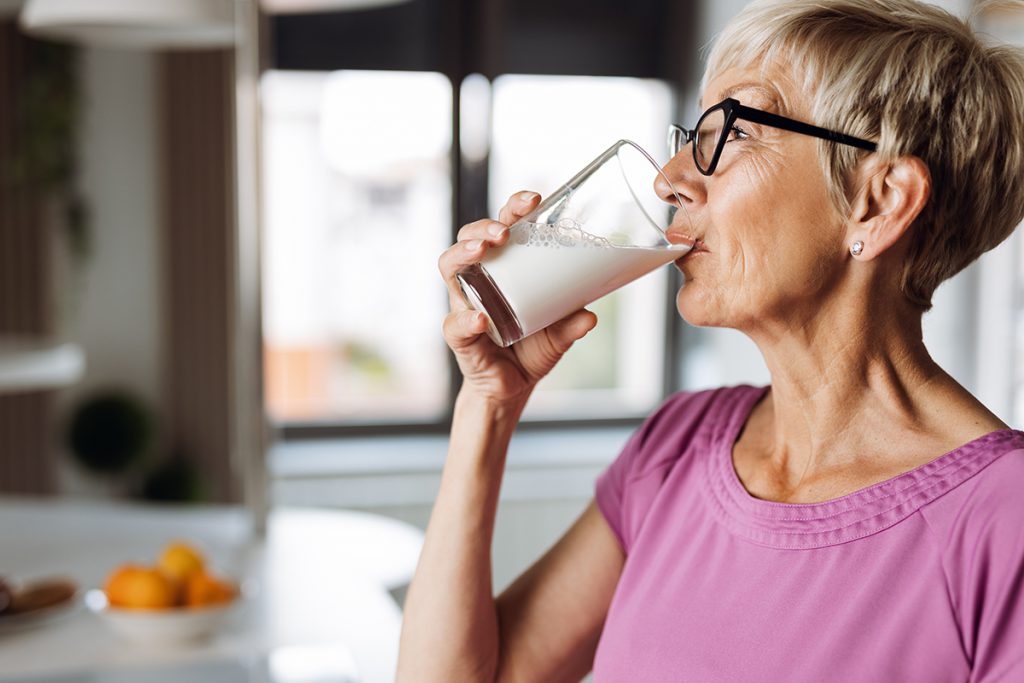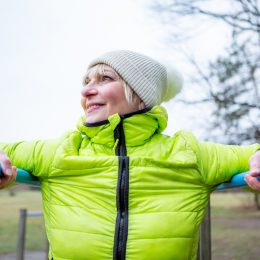Bone Health and Osteoporosis: The SilverSneakers Guide
It’s important to have strong, healthy bones as you get older. Here’s why — and how to do it.

It’s easy to think of your bones as fixed objects. After all, you stopped growing years ago.
In fact, your bones have been active all this time. As you age, keeping your bones healthy and strong becomes an essential part of maintaining your mobility and independence.
Use this guide to better understand what’s going on in your bones and, most importantly, how to protect them for years to come.
Get and stay fit with SilverSneakers! Choose from dozens of different Community classes, visit a participating fitness location, or view the current schedule of SilverSneakers LIVE online classes.
Why is bone health important?
There are 206 to 213 bones in the human body (the number of ribs and vertebrae can vary) and they are far more than just an interior framework. Bones are composed of living tissue that can regenerate. That’s why broken bones can mend on their own if they’re properly supported.
And bones serve several functions in your body. In addition to helping us move, they also:
- Protect organs, including your brain, from injury
- Store minerals like calcium and phosphorous, then release them into your body when needed
- Anchor muscles, ligaments, and tendons
- Serve as a site for development and storage of blood cells in your bone marrow
An especially crucial measure of bone health is bone density, also called bone mass. This is the amount of minerals, such as calcium, in your bones. When this amount is low, it can slow bone regeneration and cause structural issues in your bones.
How do bones change as you get older?
Bones continuously change throughout your life. They make new bone tissue and break down old tissue as a way to optimize bone function.
When you’re younger, your body makes new bone faster than it can turn over. This is why your bone density increases gradually through childhood, adolescence, and young adulthood.
Most people reach peak bone mass in their late 20s. The process shifts in the other direction when you’re in your 30s, according to the American Academy of Orthopaedic Surgeons. As you get older, you tend to lose slightly more bone density than your body can make.
This process can be particularly problematic for postmenopausal women, as hormonal changes can increase the rate of bone loss. It’s estimated that women lose up to 20 percent of their bone mass during menopause and in the first five years afterward.
There are other factors related to bone health to consider as well, including:
- The amount of calcium in your diet
- Physical activity level
- Tobacco and alcohol use
- The size of your body frame
- Family history of osteoporosis
- Thyroid hormone levels
- Use of medications like corticosteroids, cortisone, prednisone, and dexamethasone
This cascade of factors is why the U.S. Preventive Services Task Force recommends women over 65 have a baseline bone density screening.
How is bone density diagnosed?
Determining the amount of calcium and other minerals in bones is done with imaging known as a DEXA scan. It is usually done in a radiologist’s office.
You’ll lie down on a padded table while a scanning machine passes over your lower spine and hip. Another machine will pass underneath you at the same time.
The images from both machines are combined and analyzed, with results given in the form of a “T-score.” This is a measurement comparing your bone density to that of a healthy 30-year-old. The lower your score, the more bone loss you have.
Here’s how T-scores are scaled:
- +1 to -1 is considered normal bone density
- -1 to -2.5 indicates osteopenia
- -2.5 or lower means osteoporosis
What is osteoporosis?
Meaning “porous bones,” osteoporosis is a progressive condition in which the loss of bone density increases the risk of fracture, as bone structure becomes weaker. People with osteoporosis most often break bones in the wrist, spine, and hip, according to the U.S. National Library of Medicine.
Because menopause affects bone loss so profoundly, women have a higher rate of osteoporosis. The Endocrine Society estimates that half of all postmenopausal women will develop osteoporosis — and most will suffer a fracture as a result.
Although women have higher rates of the condition, men can develop osteoporosis too, particularly those with risk factors like family history, smoking, and use of some medications.
For both men and women, osteoporosis can happen gradually and without symptoms. In fact, some people only find out they have the condition after they’ve broken a bone and gotten a scan as a result.
That’s why screening is so important, to catch bone density concerns early.
What is osteopenia?
Simply having low bone mass doesn’t mean you automatically have osteoporosis. If your T-score is within a certain range that’s higher than that of osteoporosis but not high enough to indicate normal bone mass, that’s a condition called osteopenia. About 34 million Americans have osteopenia, according to the Cleveland Clinic.
Similar to how prediabetes can be a warning sign that you’re at higher risk for developing diabetes, osteopenia may progress into osteoporosis. But it’s not inevitable.
Your doctor may prescribe medication geared toward increasing bone mass. And lifestyle changes like exercising and eating more calcium-rich foods could lower your chances of developing osteoporosis.
How is osteoporosis treated?
There are medications that can help prevent and treat osteoporosis. These include:
- Bisphosphonates
- Estrogen agonists/antagonists (also called selective estrogen receptor modulators or SERMs)
- Calcitonin
- Parathyroid hormone
- Estrogen therapy
- RANK ligand inhibitor
Your healthcare provider may not wait until your T-score indicates osteoporosis, but instead might suggest one of these medicines if you have osteopenia or you’re at higher risk of fracture in the future.
You’re also more likely to have medication suggested as a treatment if you have other health concerns that increase risk. This includes having a low body weight or taking medication that lowers bone density, like prednisone or cortisone.
What role does exercise play for bone health?
Exercise is a huge part of keeping your bones strong. Like muscle, bone is “use it or lose it.” Bone is living tissue that can become stronger with regular use — or weaker if you don’t use it, reports the National Institutes of Health.
The best exercises for healthy bones involve putting a little stress on them. This will prompt your bones to add mass in response. Try strength-training and weight-bearing activities.
Keep in mind that your body is also a weight, so an exercise like walking is considered a bone-building workout. Even if you’re not holding weights, you’re still subjecting your bones to stress as you stride.
Other options include:
- SilverSneakers fitness classes
- Climbing stairs
- Lifting weights
- Low-impact aerobics
Depending on your fracture risk, you may be advised to limit or avoid high-impact activities if you have osteoporosis. But you can still mix balance, strength, and flexibility workouts into your exercise routine. These can help you maintain a full range of motion and build muscle around bones so they are more supported.
Subscribe to our newsletter
It's quick and easy. You could be one of the 13 million people who are eligible.
Already a member? Click to discover our 15,000+ participating locations.
Follow Us
If you have osteoporosis or osteopenia, be sure to talk with your doctor or other healthcare provider before starting an exercise plan to make sure it’s the right fit for you. Then get moving: Your bones will thank you for it.
Press play to try a bone-strengthening workout that’s designed for those with osteoporosis:
What other lifestyle habits boost bone health?
Whether you have osteopenia and want to keep it from becoming osteoporosis or you want to slow the progression of osteoporosis, there are several lifestyle habits that can make a big difference.
These tips can help you maintain strong, healthy bones as you age.
Include enough calcium in your diet. Calcium helps build strong bones. For women ages 51 and older and men ages 71 and older, the Recommended Daily Allowance (RDA) of calcium is 1,200 mg daily. Men ages 51 to 70 should aim for 1,000 mg daily.
Foods rich in calcium include dairy products, broccoli, dark leafy greens, canned sardines or salmon with bones, soy products, and almonds. If it’s challenging to get enough calcium through your diet, ask your healthcare provider about taking supplements.
Recommended reading:
6 Foods That Strengthen Your Bones
5 Sneaky Signs You’re Not Getting Enough Calcium
Get more vitamin D. In order to absorb calcium, your body needs adequate amounts of vitamin D. The RDA from ages 19 to 70 is 600 international units (IUs) daily. For adults ages 71 and older, that goes up to 800 IUs every day.
Sunlight can kick off vitamin D production, and you can also find the vitamin in foods like salmon, trout, mushrooms, eggs, and fortified products, like milk. This is another instance where you may want to talk to your healthcare provider about supplements, especially ones that combine calcium and vitamin D.
Quit tobacco. Even if you’re getting plenty of calcium, it won’t be as effective if you smoke or use tobacco. That’s because nicotine lowers your body’s ability to absorb calcium. Nicotine also slows the rate of bone regeneration, so your bones won’t heal as quickly. Because of these issues, people who smoke are at increased risk for developing osteoporosis.
Drink in moderation. Chronic alcohol use has been associated with higher risk of fractures in the hip, spine, and wrist. Alcohol also interferes with the balance of calcium in the body. Plus, it can negatively impact hormone production, which can make it harder for your body to absorb calcium.
Sources:
Importance of bone health/osteoporosis medicine/exercise: National Institutes of Health (2018). Bone Health for Life
Bone anatomy: Johns Hopkins Medicine (2022). What is bone?
Bone density/osteopenia: National Library of Medicine (2022). Bone Density
Bone changes as you age: National Library of Medicine (2022). Aging changes in the bones, muscles, and joints and Endocrine Society (2022). Menopause and Bone Loss
DEXA scan: National Library of Medicine (2022). Bone Density Scan
Lifestyle changes: Mayo Clinic (2021). Bone health: Tips to keep your bones healthy
Smoking and Alcohol: National Institute of Arthritis and Musculoskeletal and Skin Diseases (2018). Smoking and Bone Health
Take Your Favorite SilverSneakers Classes Online!
SilverSneakers members can access live fitness classes and wellness workshops through SilverSneakers LIVE. See the latest schedule and RSVP for classes here.
Not a member? If you have a Medicare Plan, it may include SilverSneakers — at no additional cost. Check your eligibility instantly here.
Not eligible for SilverSneakers? You can still get 200+ free SilverSneakers On-Demand videos and stay in touch with us by creating your online account.





